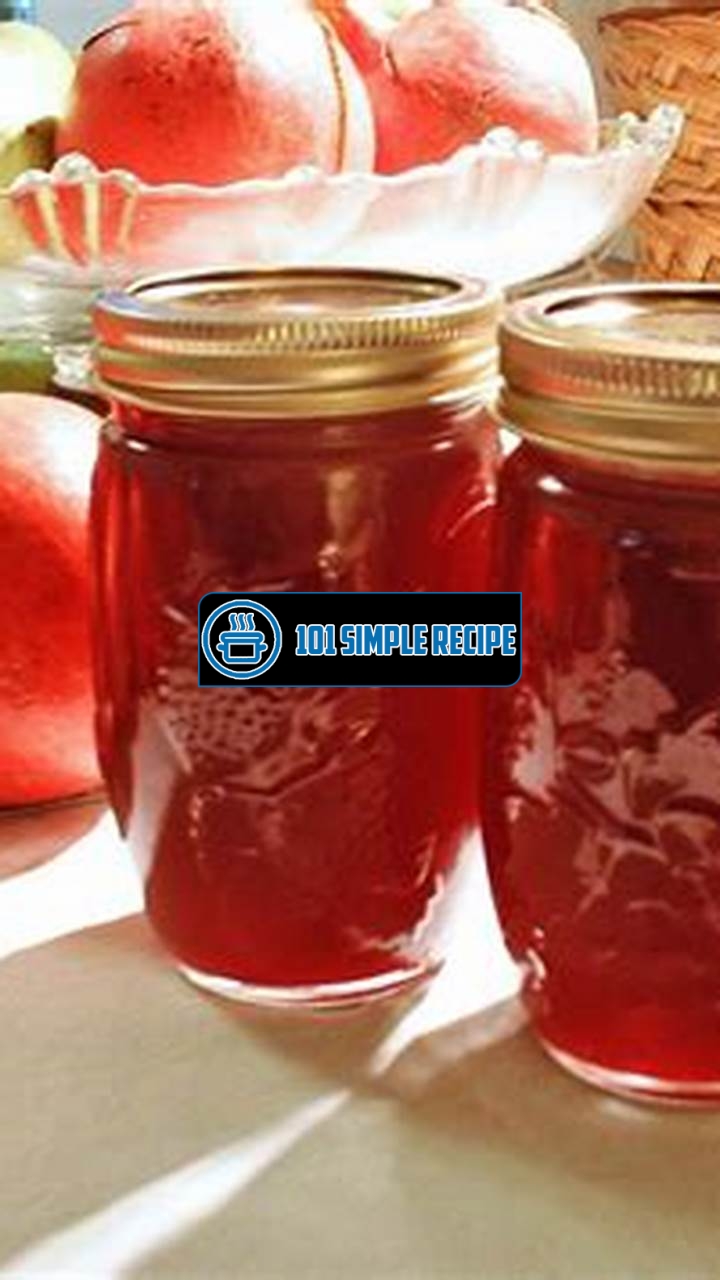Are you craving a sweet and tangy treat to satisfy your taste buds? Look no further! This delicious pomegranate jelly recipe is the perfect solution. ✨ Not only is it easy to make, but it also bursts with flavor and goodness. Imagine spreading this delightful jelly on your morning toast or using it as a glaze for your favorite meats. With just a few simple ingredients and a little bit of time, you can create a homemade jelly that will impress your family and friends. So, let’s get started and dive into the tantalizing world of pomegranate jelly!

What is Pomegranate Jelly with Pectin?
Discover the delicious and versatile pomegranate jelly made with the use of pectin. Pomegranate jelly is a sweet and tangy spread that can be used in a variety of ways. It can be spread on toast or sandwiches, used as a topping for pancakes or waffles, or even enjoyed as a filling in cakes and pastries. The addition of pectin gives the jelly its firm texture and allows it to set properly. Pectin is a natural ingredient derived from fruits, particularly citrus fruits, and is commonly used as a gelling agent in jams and jellies.
The Basics of Pomegranate Jelly
Pomegranate jelly is made by combining pomegranate juice, sugar, and pectin. The juice is typically obtained by extracting the seeds from fresh pomegranates and pressing them to release the juice. The juice is then combined with sugar and pectin in a saucepan and heated until the mixture reaches a rolling boil. The mixture is then poured into sterilized jars and left to cool and set.
One key aspect of making pomegranate jelly is the ratio of pectin to fruit juice. The proper ratio ensures that the jelly sets properly and has a good texture. It is important to follow the recipe instructions and use the recommended amount of pectin for the desired consistency.
Pomegranate jelly has a vibrant red color and a sweet and tart flavor. Its versatility makes it a popular choice for homemade gifts or for adding a touch of luxury to your breakfast or dessert. The use of pectin ensures that the jelly has a smooth and jelly-like texture, making it easy to spread or use as a filling.
Benefits of Using Pectin in Pomegranate Jelly
Using pectin in pomegranate jelly offers several benefits. Firstly, pectin acts as a natural thickener, helping the jelly to set properly. This ensures that the jelly has a firm texture and does not become too runny.
Secondly, pectin allows for a shorter cooking time. Without pectin, the jelly would need to be cooked for a longer period to achieve the desired consistency. The use of pectin reduces the cooking time, making the process quicker and more efficient.
Additionally, pectin enhances the flavor of the pomegranate jelly. It helps to bring out the natural sweetness of the fruit and balances the tartness. The result is a well-rounded and delicious jelly that is sure to impress.
Choosing the Right Pectin for Your Pomegranate Jelly
When it comes to choosing the right pectin for your pomegranate jelly, there are a few options to consider. There are two main types of pectin available: liquid pectin and powdered pectin.
Liquid pectin is often preferred for making pomegranate jelly as it is easier to use. It is already in a liquid form, so it can be easily incorporated into the jelly mixture. Powdered pectin, on the other hand, needs to be mixed with water before adding it to the mixture. Both types of pectin are effective in helping the jelly set properly, so it ultimately comes down to personal preference.
It is also important to check the expiration date on the pectin package. Using expired pectin may result in the jelly not setting properly or not achieving the desired consistency. Fresh and quality pectin will ensure the best results for your pomegranate jelly.
Getting Started: Essential Ingredients and Tools
When it comes to making the perfect pomegranate jelly with pectin, there are a few key ingredients and tools that you’ll need to have on hand. Understanding these essential elements will ensure that your jelly turns out delicious and flavorful every time.
Quality Pomegranate Juice: The Star Ingredient
At the heart of any great pomegranate jelly recipe is high-quality pomegranate juice. The flavor of your jelly will depend largely on the quality and freshness of the juice you use. Look for 100% pure pomegranate juice without any added sugars or artificial ingredients. You can use store-bought pomegranate juice or even make your own by extracting the juice from fresh pomegranates. This ensures that your jelly will have a vibrant, natural flavor that shines through.
The Role of Pectin in Jelly Making
Pectin is a naturally occurring substance found in the cell walls of fruits. It acts as a gelling agent and is essential for achieving the desired jelly-like consistency in your pomegranate jelly. Pectin helps to thicken the juice, giving your jelly a smooth and spreadable texture. While some fruits naturally contain high levels of pectin, pomegranates are not one of them. Therefore, it’s important to add pectin to your pomegranate juice to ensure that it sets properly. You can find pectin in the baking aisle of most grocery stores or online.
Essential Tools and Equipment for the Process
In addition to the key ingredients, you’ll also need a few essential tools and equipment to make your pomegranate jelly. Here’s what you’ll need:
- A large, heavy-bottomed pot: This will be used for cooking the pomegranate juice and pectin mixture. Choose a pot that is large enough to hold the ingredients without overflowing.
- A candy thermometer: This will help you monitor the temperature of the jelly mixture as it cooks. It’s important to reach and maintain the correct temperature to ensure that the jelly sets properly.
- Jelly jars: You’ll need clean, sterilized jars to store your finished pomegranate jelly. Make sure to choose jars with tight-fitting lids to help preserve the freshness of the jelly.
- A canning funnel: This funnel is specifically designed for filling jars with hot liquids. It helps to minimize spills and ensures that your jars are filled evenly.
- A ladle or measuring cup: This will be used to transfer the hot jelly mixture into the jars.
- A clean kitchen towel: You’ll need this to wipe down the rims of the jars before sealing them. It helps to create a tight seal and prevent any contamination.
With these essential ingredients and tools in hand, you’re well-equipped to embark on your pomegranate jelly making journey. Don’t forget to follow the recipe and instructions carefully to achieve the perfect balance of flavors and textures. Enjoy the process and savor the delicious results!
Step-by-Step Guide to Making Pomegranate Jelly with Pectin
Follow a detailed walkthrough of the process to create your own delectable pomegranate jelly.
Preparing the Pomegranate Juice
To begin making your pomegranate jelly, you’ll first need to prepare the pomegranate juice. Start by gathering fresh, ripe pomegranates. Look for fruits that are deep red in color and feel heavy in your hand. This indicates that they are fully ripe and bursting with flavor.
Next, cut the pomegranates in half and gently scoop out the seeds. Place the seeds in a large bowl and crush them using a potato masher or the back of a spoon. This will help release the juice from the seeds.
Once you have crushed all the seeds, transfer them to a clean, fine-mesh strainer set over a large bowl. Press down on the seeds to extract as much juice as possible. You can also give the seeds a gentle squeeze with your hands to release any remaining juice.
Now that you have your fresh pomegranate juice, it’s time to move on to the next step in the jelly-making process.
Adding and Heating the Pectin
Pectin is a natural thickening agent that is essential in making jelly. It helps the liquid to gel and gives the jelly its firm texture. In this recipe, we will be using pectin specifically designed for making jellies and jams.
To add the pectin to the pomegranate juice, start by measuring the required amount according to the instructions on the package. Typically, the ratio is one package of pectin for every four cups of juice.
Once you have measured the pectin, pour it into a small saucepan along with a small amount of sugar. The sugar helps to balance the tartness of the pomegranate juice and enhance the flavor of the jelly.
Place the saucepan over medium heat and stir the pectin and sugar mixture until it dissolves completely. Continue stirring until the mixture comes to a gentle boil.
Once the mixture has reached a boil, let it simmer for a few minutes to activate the pectin. Stir constantly to prevent the mixture from sticking to the bottom of the saucepan. This will ensure that the pectin is evenly distributed throughout the jelly.
Now that the pectin has been added and heated, it’s time to move on to the final step in the jelly-making process.
Proper Sterilization and Canning Techniques
Before you can enjoy your homemade pomegranate jelly, it’s important to properly sterilize and can the jars to ensure food safety and extend the shelf life of the jelly. This step is crucial in preventing any potential bacterial growth.
Start by washing the jars, lids, and bands with hot, soapy water. Rinse them thoroughly to remove any soap residue. Then, place the jars and lids in a large pot filled with enough water to cover them completely. Bring the water to a boil and let the jars simmer for at least 10 minutes to sterilize them.
While the jars are boiling, prepare the hot pomegranate jelly mixture. Carefully remove the jars from the boiling water using jar tongs and place them on a clean, dry towel. Fill each jar with the hot jelly mixture, leaving about a quarter-inch of headspace at the top.
After filling the jars, wipe the rims clean with a damp cloth to remove any residue that could interfere with the sealing process. Then, place the lids on the jars and tighten the bands until they are fingertip tight.
Return the filled jars to the boiling water in the pot and let them process for the recommended time according to your altitude. This ensures that the jars are properly sealed and a vacuum is created inside, which prevents the growth of bacteria.
Once the processing time is complete, carefully remove the jars from the boiling water and place them on a towel to cool. As they cool, you will hear a satisfying “pop” sound, indicating that the jars are properly sealed. This sound is music to any home canner’s ears!
Allow the jars to cool completely before storing them in a cool, dark place. The pomegranate jelly will continue to set as it cools, creating the perfect texture.
Now that you have successfully completed all the steps in making pomegranate jelly with pectin, you can enjoy the delicious fruits of your labor! Spread the jelly on toast, use it as a glaze for meat dishes, or give it as a thoughtful homemade gift to friends and family.
Your pomegranate jelly is sure to impress with its vibrant color and burst of fruity flavor. So go ahead, try this recipe and embark on your own jelly-making adventure!
Exploring Variations: Flavorful Additions to Your Pomegranate Jelly
When it comes to creating a delicious pomegranate jelly, the possibilities are endless. By getting creative and experimenting with different flavors, you can elevate your jelly to a whole new level. In this article, we will explore various additions that will enhance the flavor of your pomegranate jelly. Whether you prefer a little extra zing with spices and herbs, the refreshing taste of different fruit juices, or the natural sweetness of sweeteners and natural enhancers, there is something for everyone to enjoy.
Spices and Herbs for Extra Zing
If you’re looking to add an extra kick to your pomegranate jelly, spices and herbs are the way to go. They can transform a simple jelly into a complex and tantalizing blend of flavors. Consider adding a pinch of cinnamon, a hint of ginger, or a sprinkle of cardamom to give your jelly a warm and aromatic twist. These spices not only bring out the natural sweetness of the pomegranate but also add depth and complexity to the overall flavor profile. Experiment with different combinations and find the one that tickles your taste buds the most.
Integrating Different Fruit Juices
Why limit yourself to just pomegranate juice when you can explore a world of fruit flavors? By integrating different fruit juices into your pomegranate jelly recipe, you can create a unique and dynamic flavor profile that will leave everyone craving for more. Consider using citrus juices like orange or lemon to add a tangy twist or opt for tropical flavors like pineapple or mango to transport your taste buds to a sun-soaked paradise. The options are endless, so let your imagination run wild and experiment with different fruit juice combinations.
Sweeteners and Natural Enhancers
Sweeteners and natural enhancers can take your pomegranate jelly to a whole new level of sweetness and flavor. While pomegranate juice itself is already naturally sweet, adding a touch of honey, agave syrup, or maple syrup can further enhance the sweetness and balance out any tartness. Additionally, consider incorporating natural enhancers like vanilla extract or almond extract to add a subtle layer of complexity and aroma to your jelly. Remember, a little goes a long way, so start with small amounts and adjust according to your taste preferences.
Note: Remember to use high-quality pectin to ensure a proper jelly consistency.
With these flavorful additions in mind, you are well-equipped to create a pomegranate jelly that will tantalize the taste buds of everyone who tries it. Remember to have fun and experiment with different flavor combinations until you find the perfect balance. Whether you prefer the zing of spices, the refreshing taste of different fruit juices, or the natural sweetness of sweeteners and natural enhancers, your pomegranate jelly is bound to be a crowd-pleaser. So get creative and enjoy the process of making your own delicious and flavorful pomegranate jelly!
Preserving and Storing Your Pomegranate Jelly
When it comes to homemade pomegranate jelly, preserving and storing it properly is essential for long-lasting enjoyment. By following the right techniques, you can ensure that your flavorful jelly stays fresh and delicious for months. In this article, we will explore the best methods for preserving and storing your homemade pomegranate jelly, including proper canning techniques, refrigeration and freezing tips, as well as ensuring the safety and quality of the preserved jelly.
Proper Canning Techniques for Longer Shelf Life
One of the most popular ways to preserve pomegranate jelly is through canning. Canning not only extends the shelf life of your jelly but also retains its flavor and texture. To begin the canning process, you will need sterilized jars and lids. After filling the jars with the jelly, make sure to remove any air bubbles by gently tapping the jars on a flat surface. Secure the lids tightly, leaving just enough space for air to escape during the canning process.
Next, you can choose between two canning methods: the water bath canning or the pressure canning. Water bath canning is suitable for high acid foods like pomegranate jelly. Simply place the jars in a large pot filled with boiling water and process them for the recommended time. On the other hand, pressure canning is necessary for low acid foods. It involves using a pressure canner to reach higher temperatures that kill all bacteria, ensuring the safety of your preserved jelly. Remember to follow the exact canning instructions and processing times for your specific recipe.
Refrigeration and Freezing Tips
If you prefer a quicker and easier method of preserving your pomegranate jelly, refrigeration and freezing are great options. After making the jelly, let it cool completely before transferring it to sterilized jars or airtight containers. Store the jars in the refrigerator, where the jelly can last for up to three months. Freezing the jelly is another convenient choice. Pour the jelly into freezer-safe containers or ice cube trays, leaving some room for expansion. It’s important to note that frozen pomegranate jelly may undergo some texture changes but can still be enjoyed in various culinary applications.
Ensuring the Safety and Quality of Preserved Jelly
To ensure the safety and quality of your preserved pomegranate jelly, there are a few key factors to consider. First, always use fresh and ripe pomegranates to make your jelly. The quality of the fruit directly impacts the flavor and texture of the final product. Second, be diligent about maintaining cleanliness and hygiene throughout the jelly-making and preserving process. Sterilize all equipment, jars, and utensils to prevent any bacteria from contaminating the jelly.
Additionally, it’s essential to check the seals on your jars of preserved jelly regularly. A proper seal is crucial for preserving the jelly effectively. If you notice any jars with broken seals or signs of spoilage, discard them immediately to avoid consuming unsafe jelly. Lastly, store your preserved pomegranate jelly in a cool, dark place, away from direct sunlight or heat sources that can accelerate spoilage.
By following these guidelines for preserving and storing your homemade pomegranate jelly, you can ensure its long-lasting enjoyment. Whether you choose the canning, refrigeration, or freezing method, you can savor this delightful jelly whenever you desire. Cheers to the flavors of pomegranate captured in a jar!
Frequently Asked Questions
Here are some frequently asked questions about making pomegranate jelly with pectin:
| No. | Questions | Answers |
|---|---|---|
| 1. | Can I substitute pectin with gelatin? | No, gelatin and pectin work differently in preserving and setting the jelly. It is recommended to use pectin for this recipe. |
| 2. | How long does the pomegranate jelly last? | When properly stored in a sealed jar in the refrigerator, pomegranate jelly can last for up to 1 year. |
| 3. | Can I use frozen pomegranate seeds? | Yes, you can use frozen pomegranate seeds. Thaw them before extracting the juice for the jelly. |
| 4. | What can I do if the jelly doesn’t set? | If the jelly doesn’t set, you can reboil it with additional pectin following the package instructions. |
| 5. | Can I use honey instead of sugar? | While it may alter the taste and texture, you can use honey as a substitute for sugar. Keep in mind that the flavor profile will be different. |
| 6. | Can I can the pomegranate jelly? | Yes, you can preserve the pomegranate jelly by using proper canning techniques. Ensure the jars are properly sealed and processed in a water bath. |
Thank You for Reading!
We hope you found this pomegranate jelly recipe with pectin helpful and inspiring. Don’t hesitate to experiment with different flavor variations and share your creations with us. Make sure to visit our website again for more delicious recipes and culinary tips. Happy jelly making!
Jump to Recipe
Pomegranate Jelly Recipe with Pectin

Learn how to make homemade pomegranate jelly using pectin. This easy recipe yields a flavorful and vibrant jelly that’s perfect for spreading on toast or using as a topping. Get your pomegranate fix with this delicious and nutritious jelly!
- 4 cups pomegranate juice
- 4 cups granulated sugar
- 1 package (1.75 oz powdered pectin)
- 1/4 teaspoon butter (optional, helps reduce foaming)
- In a large pot, combine the pomegranate juice and powdered pectin. Stir well to dissolve the pectin.
- Bring the mixture to a rolling boil over high heat, stirring constantly.
- Add the sugar and butter to the pot. Continue to stir and boil the mixture for an additional 1 minute.
- Remove the pot from the heat and skim off any foam that forms on top.
- Ladle the hot jelly into sterilized jars, leaving 1/4 inch of headspace. Seal the jars tightly.
- Process the jars in a boiling water bath for 10 minutes. Remove from the water and let cool for 24 hours. The jelly will set as it cools.
- Enjoy your homemade pomegranate jelly on toast, scones, or as a delicious glaze for meats.






